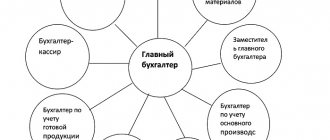Sample job description for an architect
General provisions
- The architect is hired and fired by the director of the company on the recommendation of the deputy. construction director.
- The architect is operationally subordinate to the deputy. construction director.
- A candidate for this job must meet the following criteria:
- higher education in construction;
- Three years of experience in building design.
- In the absence of an architect (vacation, illness, business trip), his duties are temporarily transferred to another specialist appointed by the deputy. construction director.
- The architect is required to understand:
- legal framework regulating construction activities;
- regional traditions and features relevant to project activities;
- industry standards and regulations;
- standards for the preparation of construction documentation;
- current environmental, aesthetic, ergonomic and technical criteria that the designed buildings must meet;
- basic methods for designing popular structures;
- stages of collecting and processing information required in the design of structures;
- methods for carrying out calculations necessary in architecture and methods for checking their reliability;
- technological solutions used in construction activities;
- principles of working with construction drawings and sketches;
- features of the design and construction of buildings depending on natural conditions, seasonal factors and other specific aspects;
- features of building materials and structures;
- basic economic parameters of construction activities;
- methods for diagnosing shortcomings and defects in designed structures;
- best practices in architectural practice;
- peculiarities of perception of architectural solutions by specialized specialists and other persons;
- methods of working with specialized software.
- The architect is guided by:
- current legislation;
- industry regulations;
- corporate documentation;
- contents of the instructions.
Functions
The Architect is responsible for the following duties:
- Collection and analysis of data necessary in architectural and construction activities.
- Inspection of the site intended for the construction of the designed structure.
- Development of architectural and construction solutions in accordance with local specifics and customer wishes.
- Preparation of architectural solutions and their defense at relevant meetings.
- Finalization of projects in accordance with the wishes of the customer and comments received from specialists.
- Coordination of designed structures with regulatory authorities.
- Participation in planning the schedule of construction activities.
- Monitoring the construction of designed structures.
- Participation in the company’s development of technical specifications and other documentation on architectural solutions.
- Preparation of models, drawings, sketches of designed structures and their individual sections.
- Carrying out the necessary technical and economic calculations for construction and architectural activities.
- Participation in the acceptance of structures from contractors.
- Interaction with other specialists to resolve issues in the field of architecture and design.
- Preparation of the design part of documentation for tenders in which the company participates.
- Monitoring the compliance of designed structures with the required standards for safety, aesthetics, and ergonomics.
- Introduction of advanced architectural solutions into practice.
Responsibility
The employer has the right to hold the architect accountable in the following situations:
- For offenses committed during the performance of official functions - in accordance with the norms of current legislation.
- For failure to perform job functions defined in the instructions - in accordance with the provisions of labor legislation.
- For causing material damage to the company - within the limits defined in the sections of the current legislation.
Rights
The architect is endowed by the employer with the rights:
- Suggest measures to improve the company's activities.
- Participate in company management meetings regarding architectural projects.
- Receive information necessary for your activities from company employees.
- Become familiar with draft corporate documents related to architectural issues.
- Require corporate management to provide the conditions necessary for the effective performance of professional functions.
- Endorse documentation within your responsibility.
II. Job responsibilities
The responsibilities of the chief project architect include:
1. Management of design and survey work, including the provision of expert advisory services at the pre-project stage of designing a capital construction project:
— Providing consulting services to the customer in the field of architecture, including the preparation of preliminary studies at the pre-design stage of construction and implementation of the facility
— Determination of the goals and objectives of the project, its main architectural and space-planning parameters and the strategy for its implementation in connection with the customer’s requirements for the future use of the capital construction project
— Planning and control of tasks for collecting, processing and documenting data for the development of a conceptual architectural project, necessary for the development of the architectural section of the project documentation
— Planning and control of additional studies and engineering surveys
— Checking the completeness and assessing the quality of the initial data, task data for architectural and construction design, necessary for the development of the architectural section of the design documentation
— Summary analysis of initial data, data from design assignments, collected data and data obtained as a result of additional research and engineering surveys, and provision of consulting services to the customer on the coordination of project implementation
— Taking into account the conditions for the future implementation of the object and providing consulting services to the customer on developing a strategy for its implementation
— Consulting the customer at the stage of developing a task for architectural and construction design
2. Management of design work, including organization and general coordination of work on the development of design documentation for capital construction projects:
— Determining the customer’s priorities, preparing justifications for the architectural project, including functional, volumetric-spatial, architectural and artistic, constructive and technological justifications
— Coordination of the scope of services and design work for the preparation of a contract and carrying out design and survey work and design work
— Determination of criteria for selecting participants in the work, selection of performers and coordination of their activities when developing the architectural section of the project documentation
— Preparation and approval of tasks for the preparation of the architectural section of project documentation
— Coordination of tasks for the development of design solutions for other sections of the design documentation, including structural and engineering sections
— Planning and control of tasks for the development of the architectural section of project documentation
— Coordination of architectural and space-planning solutions with design solutions developed according to other sections of project documentation
— Monitoring compliance of design and estimate documentation for capital construction projects with customer requirements, technical regulations, standards, norms, rules
— Making changes to architectural and space-planning solutions in accordance with the requirements and recommendations of the customer and authorized organizations
— Monitoring compliance with architectural and construction design technology
— Planning of preparation and control of completeness and quality of execution of working documentation developed in accordance with the approved project
— Preparation of design documentation for approval by the customer
3. Preparation and protection of project documentation:
— Planning the preparation and control of the completeness and quality of the design of the architectural section of the project documentation
— Preparation for approval of a set of project documentation
— Presentation, approval and acceptance of the results of work on the preparation of the architectural section of the project documentation
— Ensuring coordination of related sections of the project with the customer
— Protection of the architectural section of project documentation in expert authorities
— Introducing changes to the architectural section of project documentation and coordinating changes to other sections in accordance with the requirements and recommendations of the customer and authorized organizations
— Planning of preparation and control of completeness and quality of execution of working documentation developed in accordance with the approved project
— Approval of the results of the architectural section of the design documentation
4. Carrying out designer supervision activities over the design of a capital construction project and work to identify defects during the operation of the facility:
— Ensuring compliance of solutions with project documentation with the architectural concept and architectural design
— Compliance control and approval in case of deviations from the architectural design of decisions on sections of project documentation, including structural and engineering
— Planning and control of work and designer’s supervision activities at the construction stage and during the warranty period of operation of a capital construction project
— Monitoring compliance with the requirements of project documentation
— Confirmation of the volume and quality of construction work performed, including the building materials used
— Development, coordination with the customer and monitoring the implementation of recommendations and instructions on the procedure for eliminating deviations and violations identified during designer supervision activities and work to identify defects during the operation of the facility
— Monitoring the maintenance of established design documentation based on the results of designer’s supervision and work to identify defects during the operation of the facility
5. Providing consulting services and performing design work at the stage of implementation of capital construction projects:
— Preparation of tender documentation packages for the architectural part of the project
— Coordination of the composition of tender documentation
— Consultations with the customer on the selection of contractors and subcontractors to participate in the project
— Preparation of as-built documentation or its verification, consulting the contractor on as-built documentation
— Coordination of as-built documentation for the facility prepared by the contractor
— Work in state acceptance committees
— Consulting the customer on optimal operation of the facility, preparing instructions for operating the facility
— Providing activities related to identifying the causes of defects during the operation of the facility
— Development, coordination with the customer and monitoring the implementation of recommendations and instructions on the procedure for eliminating identified defects
— Monitoring the progress of work to eliminate defects at the constructed facility
6. Administration of project management processes, including contractual relations, financial procedures and document flow within the framework of the project activities of an architectural organization or division:
— Formation of a portfolio of orders for an architectural organization/division
— Preparation of current and future work plans
— Administration of contractual relations within the framework of project activities
— Determination of the goals and objectives of the project, the strategy for its implementation in connection with the customer’s requirements for the future use of the capital construction project
— Determination of cost and contract price for design to form the project budget
— Work planning by drawing up schedules for design work and their coordination with construction work
— Negotiations with the customer on packages of contracts and their contents when preparing the design of the facility
— Carrying out ongoing monitoring of the implementation of contractual relations during the production of design work, including monitoring the timing, quality of work and the project budget (monitoring the implementation of financial terms of contracts)
— Optimization of the organizational structure of the design organization/division through the distribution of functional duties and responsibilities of employees of the architectural department
— Formation of a project team and agreement with the customer on the matrix of distribution of responsibilities for the project
— Establishing rules for professional and business communications, including maintaining correspondence and document flow for the project, rules and methods for storing paper and electronic information
— Management of information resources and communications, including monitoring the organization of information systems and the flow of information during the design process
— Assessing the effectiveness of project implementation from the perspective of achieving its diverse goals
— Development, approval and control of the execution of corporate regulations governing the financial and economic activities of an architectural organization/division of a design organization
7. Expert activity on the development of the architectural profession:
— Registration of the author’s architectural concept in professional information resources and its presentation in professional publications, at public events and in means of professional socialization
— Author’s control over the preparation of assignments for the development of design documentation and special technical conditions in accordance with the developed architectural concept
— Author’s control of the implementation of the architectural concept in forms that do not involve the development of project documentation
— Coordination of the possibility of re-implementing the architectural project and the design documentation developed on its basis
— Preparation for architectural competitions
— Promotion of projects and innovative achievements in the profession, including the development of competitive proposals within the framework of architectural competitions
— Preparation of publications about projects and design activities that ensure a high creative, technical and economic level and the introduction of innovative technologies for designing objects
8. Employee management and operational management of the personnel of the creative team and/or the architectural department of the organization:
— Setting goals for the implementation of creative tasks of a team or architectural department of a design organization
— Formation of a personnel strategy for the creative team, including determining the need for labor resources of the unit based on the compliance of professional creative competencies, knowledge, skills and abilities of employees with functional and job descriptions, and monitoring its implementation
— Distribution of production tasks between workers
— Monitoring the performance of job duties by employees
— Development of proposals to improve the professional level of employees
Principles for drawing up job descriptions
Standard instructions include four sections that set out the basic parameters of a specialist’s activities:
- A common part.
- Employee functions.
- Responsibility for violations.
- His rights granted by the employer.
If the instructions are drawn up for top managers or specialists in particularly responsible positions, then an extended document format can be used. The instructions may include:
- Rules of official interactions.
- Features of the work.
- Rules for assessing employee performance (KPI).
The extended structure of the instructions is used to formalize as many aspects of work as possible. This relieves both the employer and the employee from the need for constant individual explanations.
Attention! The instructions are drawn up in two directions: “for the position” and “for the employee.” In the first version, it is universal in nature, corresponding to any employee in a certain position. In another “scenario” it has an individual form, customized for a specific valuable specialist.
a common part
Here are the general characteristics of the employee's activities:
- Who is responsible for his personnel movements?
- Who directly supervises them?
- Who replaces him during his absence?
- What provisions must he follow?
- What education and work experience criteria must he meet?
- What practical skills are needed from him?
The requirements listed in this section must guarantee the employment of a specialist with certain qualifications who is capable of performing the functions described in the next part at a high level.
Attention! There are different levels of competence for an architect. Professional standard 10.008, approved in 2017, contains 3 qualification levels: from fifth to seventh. In addition, there are 17 sublevels of qualification. Their characteristics can be used to adapt instructions to a specialist of the required level.
Responsibilities
This key section provides a list of tasks that the specialist performs. Although secondary functions may vary from employer to employer based on their industry, personnel policies, and other factors, the primary functions remain the same. Thus, for an architect, the basic responsibilities are the design of buildings, and the secondary ones are participation in the development of documentation for tenders. The larger the employing organization, the more emphasis is placed on core duties, with support tasks shifted to assistants and specialized workers.
Responsibility
This section describes options for holding an employee accountable for possible violations. Since the measure of punishment for the employee, as well as the circumstances of establishing his guilt, are prescribed in the relevant sections of civil and criminal law, this part is written in a general form. The specific circumstances of the violation will still be established during the necessary administrative and legal procedures beyond the scope of the instructions.
Rights
The final basic section that defines the capabilities that an employee uses to solve professional problems. Its content does not repeat Article 21 of the Labor Code, which gives the rights of an employee, but serves as an addition to it. The specific content of the section depends on the significance of the employee’s position, the tasks he performs and other factors. According to the general principle: the more significant the employee’s role, the more opportunities he should have.
The development of instructions goes through a number of mandatory stages.
- Writing a draft using specialized standard instructions and professional standards.
- Its review by the head of the personnel department and a lawyer.
- Making adjustments and discussing with industry experts.
- Preparation of a clean version, using the principles of official document preparation.
- Affixing the signatures of managers and specialists who took part in the approval of the document.
- Signing of instructions by the head of the company.
- Familiarization with the document of the employee himself and affixing his signature.
Attention! Changing the content of the instructions is possible only with the consent of the employee. Therefore, you need to pay close attention to the quality of its compilation from the very beginning.







